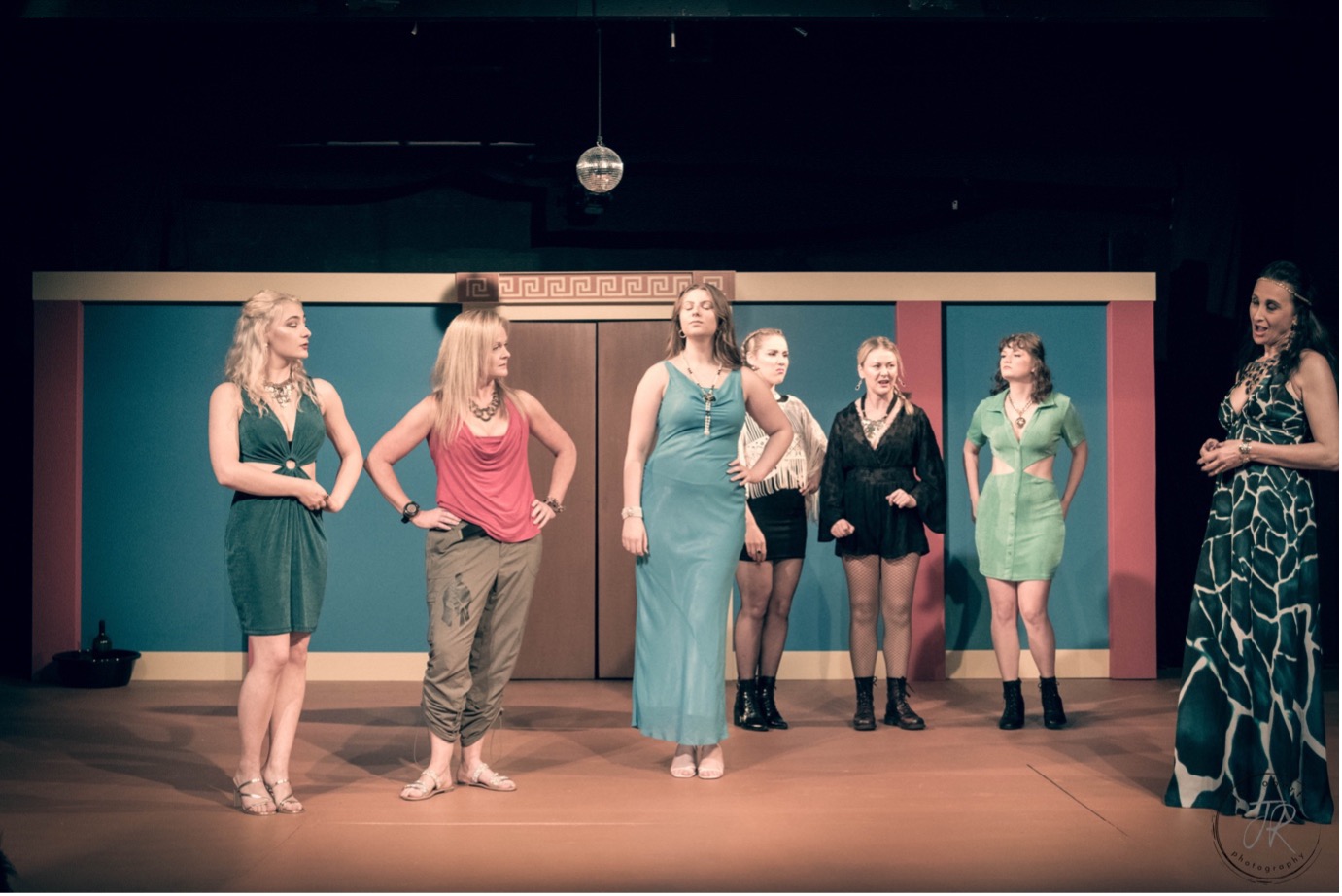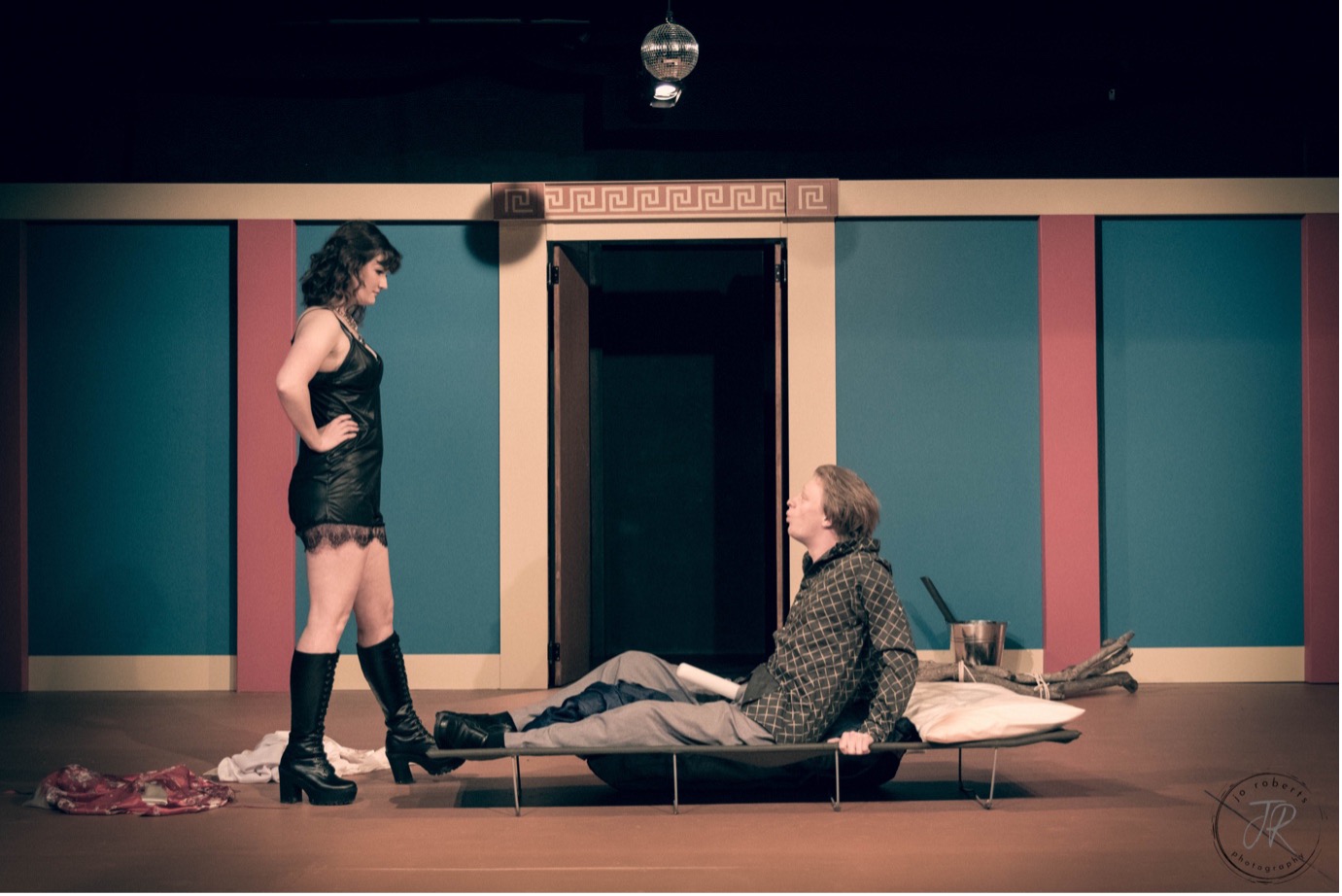You are here
- Home
- Michael Ewans
Michael Ewans
 Michael Ewans is Conjoint Professor of Drama at the University of Newcastle, Australia. He specialises in translating Greek tragedy and comedy, directing plays and chamber operas, and writing books and articles which explore how operas and dramas work in the theatre.
Michael Ewans is Conjoint Professor of Drama at the University of Newcastle, Australia. He specialises in translating Greek tragedy and comedy, directing plays and chamber operas, and writing books and articles which explore how operas and dramas work in the theatre.
In this piece for Practitioners' Voices in Classical Reception Studies, he presents a new production of Aristophanes’ Lysistrata, produced and performed in Newcastle, Australia, in 2022. To watch a performance of the dress rehearsal of the play, follow this link to YouTube: https://youtu.be/mxxWlnfKCws.
A PDF file of this essay is available for download.
Here is the text of the publicity flyer for the professional production of Lysistrata which I directed in the Newcastle Theatre Company Wiles Auditorium in Lambton, New South Wales; it played from May 25th to 28th 2022:
Stray Dogs Theatre Company presents
ARISTOPHANES: LYSISTRATA
The ultimate comedy of sex!
Fed up with their men who have been fighting almost continuously in the war between Athens and Sparta for twenty years, Lysistrata organizes a sex strike of the women. No peace? No sex!
In hilarious scenes rich with bawdy language and action, Aristophanes explores the power struggle that results from the sex strike – and the suffering on both sides as sexual frustration bites!
First performed in 411 BCE, this classic play is Aristophanes’ most popular comedy. Its message of women’s desire for peace – and their conflict with men – still resonates today.
This production features Claudia Bedford in the title role, following her portrayal of Medea in Stray Dogs’ production in 2021. It is translated and directed by Michael Ewans.
The translation was my own accurate and actable version, first published in 2010 [1]; unlike almost all previous translations it does not shirk the absolutely explicit sexual language of the original. This article will first explore selected aspects of how we staged the play, then touch on wider issues which my dramaturg, Prof. Marguerite Johnson, will pursue fully in an article in progress, In Bed with Aristophanes: Lysistrata and Female Sexuality.
Staging
Lysistrata was performed in a smallish proscenium arch theatre (seating capacity 144), with a performance space 7m wide and 5m deep, back to the façade of the entrance to the Acropolis, in front of which the action of the play takes place. There was a total cast of twenty, with some small parts doubled. The chorus (much reduced from Aristophanes’ twenty-four) comprised three Older Men and three Older Women. Modern dress was used, and masks were not. In consequence, in this intimate space, the facial expressions of every member of the cast onstage at any given moment were crucial to the success of the production; there are several passages where not only the chorus but also some individual cast members with relatively small speaking parts are present and watching the action; they devised postures, gestures and facial expressions which conveyed their reactions. Casting and costuming were very important, and the eight women were dressed in a way that accentuated their physical characteristics. Their costumes were the launching-pad for the characterization of their reactions to the dialogue throughout Scene 1.

Left to right; Xanthie Pagac as the Boiotian Woman, Melinda Hicks as Lampito, Leianna McCloy as the Korinthian Woman, Miranda Smith as the Second Athenian Woman, Crystal Davis as the First Athenian Woman, Grace Callaghan as Myrrhine, and Claudia Bedford as Lysistrata. Kalonike is out of the shot to the viewer’s left [2]
The costume of the Boiotian Woman was deliberately provocative – Kalonike will lift her miniskirt and declare her pubic hair to be ‘elegantly trimmed’ (89); the text makes it clear that Lampito from Sparta is athletic and in fine physical shape; the Korinthian Woman is said to have ‘great tits and butt’ (92), and so on round to Lysistrata. Each of the others expressed a different, horrified reaction when Lysistrata declared: ‘We must give up the prick!’ (124). Some are indicated in the text; Lysistrata observes that Myrrhine is turning away and preparing to leave, the two Athenian Women are pursing their lips and shaking their heads and Kalonike’s skin has turned pale; she’s crying (125-7). Only Myrrhine’s movement could have been shown in Aristophanes’ original, masked production; but all must be enacted in a modern maskless show, and the women whom Lysistrata does not describe must also react physically; the Boiotian and Korinthian Women with different expressions of horror, and Lampito with a more restrained reaction, befitting the fact that soon she will be the first woman to embrace Lysistrata’s plan. This Lampito does at 142-4, where the Boiotian and Korinthian Women, who were standing near their ally Lampito at this point, both mimed imploring Lampito as Lysistrata appealed to her to abstain from sex; they then turned away in disgust and disappointment when she agreed.
A second example of the need for responses from silent spectators is Lysistrata’s famous speech comparing the city to a fleece of wool (574ff.), which needs to be treated to eliminate ‘conspirators and those who form tight cliques’ (577), then carded into a basket together with immigrants, friendly foreigners, state debtors and inhabitants of Athens’ colonies. The audience for this, apart from the disbelieving Bureaucrat [3], consists of the Older Men and Women of the chorus. The women listened with ever-increasing excitement, and cheered and applauded at the end, while the men were divided; as the speech progressed, they mimed different reactions, which culminated at the end with one giving a decisive thumbs down, another offering grudging applause by way of a slow handclap, and the third sitting indifferent in stoic silence. All this business was developed during rehearsal, and much (though not all) of it was the actors’ own inventions in the light of how they conceived their characters. Again, as with the women of Scene 1, there were differences in physique and vocal tone among the chorus members which led individuals to develop their own style, both for their spoken parts and for sections like this in which they had to react to the words of others. And again this, which is in my opinion essential for a good production of the play today, would have been unthinkable in Aristophanes’ own theatre.

Chorus: Melinda Latsos confronts Robert Comber, Mick Hall and Ian Robinson, watched by Deepika Yerrakalva and Mimi Parfitt.
The scene between Myrrhine and Kinesias is one of the funniest scenes involving props in Aristophanes’ eleven surviving plays. Myrrhine mercilessly cock-teases her husband by promising to have sex with him and then bringing out a succession of items which she regards as necessities to prepare for the act – only to depart in disgust when he merely agrees to ‘think about’ voting for peace (950-1). The idea which added greatly to the power of this scene was supplied by my costume designer Melinda Hicks; she layered Myrrhine’s costume, so she performed a two-stage striptease, from a white bathrobe to a red and gold oriental silk stole to a black faux-leather negligée.

Myrrhine (Grace Callaghan) torments Kinesias (Matthew Collins) by stripping to a short black negligée.
In this picture you will also see the first of the five artificial phalluses sported by all the men who enter between this scene and the reconciliation and peacemaking near the end of the play. We used white tubes sourced from a hospital by the costume designer. As we developed this and the subsequent scenes in rehearsal, I came to realize the brilliance of Aristophanes’ sense of comic timing; he re-energized his play by introducing these erect phalluses two thirds of the way through the comedy, as visible reminders of the desperation to which Lysistrata’s sex strike has by then reduced the younger men. And their removal for the Finale is equally a visible reminder, that pent-up passion has been sated and men and women can now unite as couples in the dance.
The most important example of staging the play effectively through silent action comes in the scene of reconciliation at 1105ff. The personified figure of Reconciliation was played in the original either by a naked slave girl or by a male actor in a nude bodysuit with false breasts and a painted-on pubic patch [4]. Complete female nudity is for many reasons not desirable in a modern production of this scene. So, in my 2005 student production she was played by a bronzed young woman in a golden tiara, a golden bikini, and golden sandals, who adopted a static position back centre after guiding the ambassadors to their places. There was no problem with the costume, but there were major problems with the blocking, as the Ambassadors, two on each side of Lysistrata and Reconciliation, need to be able to see and interact with both females. We took a fresh approach in 2022, drawing on the extensive dance experience, bodily flexibility, and choreographic ability of Xanthie Pagac, who played Reconciliation.

Xanthie Pagac dancing as Reconciliation. Note how the pose captured in this photograph resembles that of dancing maenads on some Greek vases!
With her golden dress split at the front all the way up her legs, Xanthie performed fluid movements as she led the Spartan and Athenian ambassadors near to Lysistrata, and then complemented Lysistrata’s own movements with a seductive dance which was intended to arouse the ambassadors – to the point where eventually Reconciliation must exit hastily under the threat of sexual assault from front and rear. All of this was done with grace and naturalness and contributed greatly to the success of this climactic scene, which could otherwise have been received as at best tacky, at worst downright distasteful.
The treatment of the chorus has often been a major problem in modern stagings of Greek tragedy and comedy. I have seen some productions where their lyric verses were actually set to music by a composer and then sung; the words were often heard with difficulty, and the momentum of the play was virtually halted. At the opposite extreme, in David Rudkin’s 1978 adaptation of Hippolytus the chorus was represented by one young woman, who spoke all the choral text [5]. I adopt a middle position; for Lysistrata I commissioned a composer to write accompanying music for all the passages that were sung in the original, over which individual members of the chorus spoke their lines. The style was that of modern Greek bouzouki music, except for the First Spartan Ambassador’s two songs in the Finale, which opened up an altogether different dimension. This enabled audiences to respond to the disposition of music in the original play, especially in the long Third Chorus, which comprises an ingenious alternation between short stanzas which were sung in the original and spoken sections. These changes of mode were faithfully echoed in our performance.
Wider considerations
The founders of Stray Dogs Theatre Company at first expressed disquiet about my desire to stage Lysistrata in the current state of gender politics and recommended that I consider Frogs instead. I think however that the contest between the poets in the last scene of Frogs is almost unstageable today, because some of the most important parodies rely greatly on metrical subtleties in the original Greek lyrics, which cannot be reproduced in translation. Nor would we have had enough room backstage for Charon’s boat! And I wanted to direct Lysistrata, because it is Aristophanes’ most popular play [6], and contains messages about the desire for peace and the right of women to be heard which are, in the words of one of our audience members, ‘highly relevant today’.
But we need to be cautious. The sub-scene where the Athenian Ambassadors gratuitously abuse slaves who get in their way (1215ff.) was cut from all three of my productions [7] (as indeed from all the modern productions that I have seen either live or on YouTube); but the two references to marital rape are integral to Scene 1 and could cause problems. Accordingly, we added a warning, both in the program and exhibited in front of the box office:
WARNING: EXPLICIT SEXUAL LANGUAGE
TRIGGER WARNING: This play contains references to potential domestic violence which could trigger audience members who have themselves suffered domestic violence or rape.
We also made a statement in the program note, after introducing the play and the circumstances of its first performance:
We do not endorse or believe that women should suffer any form of abuse in a work or relationship setting.
What we want to show and focus on is the women’s depth of resolve, how passionately they wanted peace, and what can be accomplished when collectively women band together for their own good and to the benefit of the community around them – they can unite a country, broker peace and effectively rule the world! This is a play about finding creative responses to difficult if not impossible situations – not by yourself but together. And despite its serious message, it is a comedy!
There has been an increasing focus in Australia on attempts to eradicate domestic violence and sexual harassment since the #MeToo movement began; but this did not affect the reception of our Lysistrata in Newcastle. Packed houses laughed loud and long throughout the play and applauded warmly at curtain call; and the participants in the Q&A session after the Saturday matinee were unequivocally supportive. One male chorus member did express some anxiety about the two references to domestic violence, and this opened up a safe environment for an all-cast discussion during an early rehearsal. A talented cast of twenty, comprising people of both sexes and all ages, committed themselves wholeheartedly to presenting the show. Any thought that Lysistrata might be inappropriate in 2022 was simply negated by the play’s combination of hilarious comic scenes with serious reflection on the need to make peace rather than wage war (highly topical since Russia’s infamous invasion of Ukraine). And its feminist message of a woman’s right to be heard carried loud and clear. It is true that Aristophanes indulges in jokes about women’s alleged obsessions with drinking and sex; for example Lysistrata exclaims: ‘then we’re all nymphomaniacs’ when the other women refuse to join her in a sex strike (137), and the Bureaucrat claims that women are ‘very courageous, if they’ve had enough to drink’ (466-7); but there is a great deal of humour at the expense of randy males as well. And Aristophanes expresses a deep sympathy with and understanding of the plight of women affected by male warfare – especially in the following passage, which needs to be emotionally moving for the audience:
BUREAUCRAT Isn’t it terrible for women to speak of beating fleece
and spinning wool?
You do nothing to help with the war.
LYSISTRATA You bastard, we do
more than double what you do. First we give birth
and send our sons as soldiers off –
BUREAUCRAT Don’t say it; no past sufferings. 590
LYSISTRATA Then, when we should be having pleasure
and enjoying being young,
we sleep alone because of war. Never mind us wives,
think of unmarried girls who’re growing old in bed alone.
BUREAUCRAT Don’t men get old as well?
LYSISTRATA Yes, but it’s not the same.
When one gets back from service, even with grey hair,
he’ll soon get a young girl to marry him;
a woman’s time is short, and if she’s lost her chance,
nobody wants to marry her; she just sits at home and hopes.
We were all exhilarated by the experience of rehearsing and presenting this production, and by its very positive audience reception [8].
A videorecording of the dress rehearsal is available to view on YouTube:
Bibliography
Ewans, M. (2010) (ed. and tr.) Aristophanes: Lysistrata, The Women’s Festival and Frogs. Norman: Oklahoma University Press.
Holzinger, K. (1928) ‘Erklärungen umstrittener Stellen des Aristophanes’. SB Wien 208.5.37ff.
Revermann, M. (2006) Comic Business: Theatricality, Dramatic Technique and Performance Contexts of Aristophanes. Oxford: Oxford University Press.
Rudkin, D. (1980) Euripides: Hippolytus; a Version. London: Heinemann.
Vaio, J. (1973) ‘The manipulation of Theme and Plot in Aristophanes’ Lysistrata’. Greek, Roman and Byzantine Studies 14. 369-80.
Zweig, B. (1992) ‘The Representation of Nude Female Characters in Aristophanes’ Plays’, in Pornography and Representation in Greece and Rome (ed. A. Richlin). New York: Oxford University Press.
Notes
[1] Ewans (ed. and tr.) 2010.
[2] All photographs Ó Jo Roberts Photography. Reproduced by permission.
[3] My modernization of Aristophanes’ Proboulos or Special Commissioner.
[4] Scholars are divided about this; for a man in a bodystocking cf. Holzinger 1928: 37ff. and Vaio 1973: 279. For a naked slave girl see Zweig 1992 and Revermann 2006: 158-9. Of course, this is one of the many scholarly disputes about ancient practice which simply cannot be resolved.
[5] Rudkin 1980.
[6] 69 performances so far in the 21st century, according to the database of the Archive of Performances of Greek and Roman Drama (Accessed 17/06/2022.)
[7] In 2007 I co-directed a bilingual modern Greek/English Lysistrata for the International Theatre Institute, Cyprus, in the ancient Odeon at Paphos.
[8] There is a full analysis of the staging problems of this play, and suggested solutions, in Ewans 2010: 227-250.